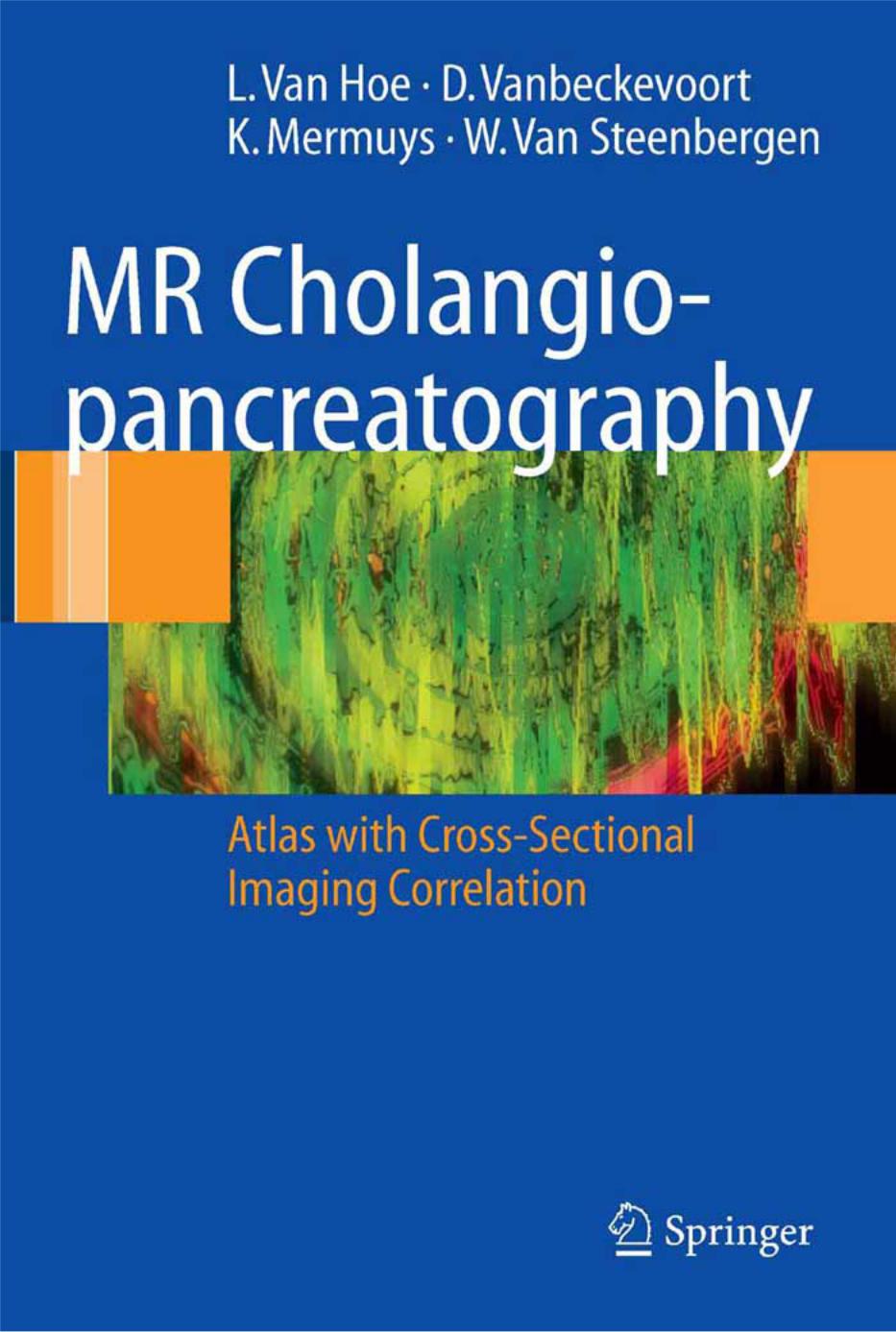
- •Preface to the Second Edition
- •Foreword to the First Edition
- •Preface to the First Edition
- •Contents
- •Abbreviations
- •1.1 Magnetic Resonance Sequences
- •1.2 Practical Setup of an MRCP Study
- •1.3 Use of Contrast Media and Drugs
- •2 Intrahepatic Bile Ducts
- •2.1 Normal Anatomy and Variants
- •2.2 Benign Nontraumatic Abnormalities
- •2.4 Malignant Tumors
- •3 Extrahepatic Bile Duct
- •3.1 Normal Anatomy and Variants
- •3.2 Benign Nontraumatic Abnormalities
- •3.4 Malignant Tumors
- •4 Gallbladder and Cystic Duct
- •4.1 Normal Anatomy and Variants
- •4.2 Benign Nontraumatic Abnormalities
- •4.4 Malignant Tumors
- •5 Vaterian Sphincter Complex
- •5.1 Normal Anatomy and Variants
- •5.2 Benign Nontraumatic Abnormalities
- •5.4 Malignant Tumors
- •6 Pancreatic Ducts
- •6.1 Normal Anatomy and Variants
- •6.2 Benign Nontraumatic Abnormalities
- •6.4 Malignant Tumors and Tumors with Malignant Potential
- •Subject Index


L. Van Hoe · D. Vanbeckevoort
K. Mermuys · W.Van Steenbergen
MR Cholangiopancreatography

L. Van Hoe · D. Vanbeckevoort
K. Mermuys · W. Van Steenbergen
MR Cholangiopancreatography
Atlas with Cross-Sectional Imaging Correlation
With 197 Illustrations in 749 Parts
123

Lieven Van Hoe, MD, PhD |
Koen Mermuys, MD |
Staff Radiologist |
Department of Radiology |
Department of Radiology |
University Hospital K.U. Leuven |
OLV Hospital |
Herestraat 49 |
9300 Aalst |
3000 Leuven |
Belgium |
Belgium |
Dirk Vanbeckevoort, MD |
Werner Van Steenbergen, MD, PhD |
Clinical Supervisor |
Professor |
Department of Radiology |
Department of Hepatology |
University Hospital K.U. Leuven |
University Hospital K.U. Leuven |
Herestraat 49 |
Herestraat 49 |
3000 Leuven |
3000 Leuven |
Belgium |
Belgium |
ISBN-10 3-540-22269-3 Springer Berlin Heidelberg New York
ISBN-13 978-3-540-22269-9 Springer Berlin Heidelberg New York
Library of Congress Control Number: 2005934304
This work is subject to copyright. All rights are reserved, whether the whole or part of the material is concerned, specifically the rights of translation, reprinting, reuse of illustrations, recitation, broadcasting, reproduction on microfilm or in any other way, and storage in data banks. Duplication of this publication or parts thereof is permitted only under the provisions of the German Copyright Law of September 9, 1965, in its current version, and permission for use must always be obtained from SpringerVerlag. Violations are liable for prosecution under the German Copyright Law.
Springer is a part of Springer Science + Business Media
springeronline.com
© Springer-Verlag Berlin Heidelberg 2006
Printed in Germany
The use of general descriptive names, registered names, trademarks, etc. in this publication does not imply, even in the absence of a specific statement, that such names are exempt from the relevant protective laws and regulations and therefore free for general use.
Product liability: The publishers cannot guarantee the accuracy of any information about dosage and application contained in this book. In every individual case the user must check such information by consulting the relevant literature.
Editor: Dr. Ute Heilmann Desk editor: Wilma McHugh
Production: Elke Beul-Göhringer
Cover design: Estudio Calamar, F. Steinen-Broo, Pau/Girona, Spain
Typesetting and reproduction of the figures: AM-productions GmbH, Wiesloch
Printed on acid-free paper
24/3151/beu-göh |
5 4 3 2 1 0 |

The more our knowledge increases, the more our ignorance unfolds.
John F. Kennedy

VII
Preface to the Second Edition
When we started preparing the first edition of this book in 1998, MR cholangiopancreatography (MRCP) was a newly developed technique successful only on high-end MRI machines equipped with strong gradients. Now,in 2005,most MRI units are capable of providing high quality images of the upper abdomen, and the technique has found its way into clinical practice.
In comparison with the first edition of the book, the basic structure remains un-
changed. Many examples have been added and older images have been replaced by new ones. Some new concepts and references have been added where needed.
It only remains to express the hope that the current edition will prove of value to all involved with the interpretation of upper abdominal MRI and MRCP.
October 2005 |
Lieven Van Hoe |

IX
Foreword to the First Edition
Since its clinical introduction, already many years ago now, the advance of MRI has not been stopped or slowed down by technical limitations. On the contrary, technical improvements have constantly triggered the further spread of MRI into new clinical domains.
Though initially introduced as a new “cross-sectional” imaging modality, it soon became obvious that MRI could also produce “continuity” images, comparable to conventional X-ray techniques. With MRI, continuity images can either be calculated from cross-sectional data or obtained directly by using volumetric projective acquisition schemes. MR angiography (MRA) is typically calculated from tomographic images using a maximum-inten- sity projection algorithm, whereas magnetic resonance cholangiopancreatography (MRCP) is often obtained with projective acquisition sequences. The two approaches each have various advantages, but they are also subject to specific limitations and artifacts.
Continuity information is extremely useful in the interpretation of the pathology of smaller tubular structures. Particularly if it can be obtained directly without the intermediate step of tomography, this information constitutes one of the advantages of MRI over ultrasonography and computed tomography (CT).
MRCP is often considered as a noninvasive alternative to diagnostic endoscopic
retrograde cholangiopancreatograhy (ERCP) because it does not necessitate contrast medium injection, irradiation, or endoscopic manipulation. However, MRCP is obtained under totally different conditions, showing images of the ducts in “physiologic” or “pathophysiologic” conditions, in contrast to ERCP, which is obtained under nonphysiologic conditions, i.e., positive injection pressure. These differences become particularly obvious in the presence of obstrucitve lesions. In addition, MR images differ not only in terms of spatial and time resolution, but also fundamentally in the physics involved in the imaging process. Diagnostic features such as calcification or air can therefore be missed on MRCP.
The authors of this textbook have aimed to provide the interested reader with a comprehensive overview of all the issues involved in the acquisition and interpretation of MRI of the biliary and pancreatic ducts,not only from the point of view of the radiologist but also from that of the endoscopist and gastroenterologist. The chapters and text are arranged accordingly, providing key facts in terms of disease and MRI.A large spectrum of diseases is illustrated, and relevant references have been included.
We hope that this volume will be a successful stimulant for an even greater spread of MRI in abdominal radiology.
Guy Marchal

XI
Preface to the First Edition
It was our aim to place at the disposal of radiologists and clinicians an atlas of Magnetic Resonance Cholangio Pancreatography (MRCP). From more than 1200 patients studied with this technique, we tried to assemble representative images of a large variety of diseases.
There is no doubt that the availability of MR systems equipped with high-power gradients opens new perspectives in the evaluation of abdominal diseases. While the non-invasive nature of MRI remains a crucial advantage over other techniques, the introduction of “snapshot” sequences providing images free of motion artifact in all patients, including those unable to cooperate, has triggered a more widespread use of this modality. A unique characteristic of state-of-the art MRI is its unrivaled capability for integrated abdominal imaging. Classic T1and T2-weighted crosssectional imaging, projective cholangiography, dynamic evaluation of contrast enhancement patterns or muscular contractility, functional imaging by assessing the uptake and excretion of specific contrast media, MR angiography, …all these techniques can be used within one session if required. It is likely, therefore, that MRI/MRCP will become an effective and cost-effective “one-stop shopping” diagnostic modality in a number of patients with suspected pancreatobiliary disease.
This book has some characteristics that should be stressed. First of all, it has been conceived as an atlas – teaching file. The format was designed so that the interested reader can “walk through”a large spectrum
of pancreatobiliary abnormalities within a relatively short period of time. Besides diseases confined to the biliary or pancreatic ducts, other conditions that may cause secondary ductal abnormalities, that have the potential to mimic ductal disease clinically,or that may be discovered incidentally during an“MRCP”study are also discussed. Most of the 200 separate topics consist of a short description of the entity under consideration, a summary of MRI/MRCP features, and a few representative images. Unlike classical teaching files, the book has rigourously been structured. With the exception of the first chapter on technique, each of the five other chapters that cover the intraand extrahepatic bile ducts, gallbladder and cystic duct, Vaterian sphincter complex, and pancreatic ducts, has been subdivided in normal anatomy and variants, benign diseases, traumatic and postoperative conditions, and malignant disorders. Hopefully, this organization will be beneficial for those faced with specific problems or questions. In order to further enhance the practical usefulness of the work,important issues such as pitfalls, specific problems in differential dignosis, and clues to a specific diagnosis have been indicated by a special symbol ! .
We hope that the readers of this book will enjoy it like we did enjoy its preparation.
Lieven Van Hoe, Dirk Vanbeckevoort,
Werner Van Steenbergen
Leuven, 1998

XIII
Contents
MRCP Technique
IIntroduction: Basic Principles
|
of Magnetic Resonance Imaging |
1 |
1 |
Technique . . . . . . . . . . . |
6 |
1.1 |
Magnetic Resonance Sequences |
6 |
# 1 |
Overview of Imaging Protocol |
6 |
# 2 |
Snapshot T2-Weighted MRI . . |
10 |
#3 |
Snapshot T2-Weighted MRI: |
|
|
Double-Echo Technique . . . . |
12 |
#4 |
Snapshot T2-Weighted MRI: |
|
|
Is Fat Suppression Required? |
14 |
#5 |
“Projective” Cholangiography |
16 |
#6 |
“Projective” Cholangiography: |
|
|
Limitations . . . . . . . . . . . |
18 |
#7 An Alternative Approach: Calculation of Maximum-
|
Intensity Projection Images . . |
20 |
#8 |
Other Techniques for Obtaining |
|
|
T2-Weighted Images . . . . . . |
22 |
#9 |
T1-Weighted MRI: |
|
|
Non-fat-suppressed Magnetiza- |
|
|
tionprepared Snapshot |
|
|
Gradient Echo . . . . . . . . . |
24 |
# 10 |
T1-Weighted MRI: Use of Fat |
|
|
Suppression . . . . . . . . . . |
26 |
1.2 |
Practical Setup of an MRCP Study |
|
# 11 |
Selection of Slice Location |
|
|
for Projective MRCP . . . . . . |
27 |
# 12 |
Selection of Slice Thickness . . |
28 |
# 13 |
Dynamic Evaluation of the |
|
|
Vaterian Sphincter Complex . . |
30 |
1.3 |
Use of Contrast Media |
|
|
and Drugs . . . . . . . . . . . |
32 |
# 14 |
Oral Contrast Media . . . . . . |
32 |
#15 Nonspecific Intravenous Contrast Media (1): Parenchymal
Organs and Lymph Nodes . . . 34
# 16 Nonspecific Intravenous Contrast Media (2): Vascular
„Roadmapping“ . . . . . . . . 36
#17 Specific Intravenous Contrast Media (1): Hepatocyte-Directed
Agents . . . . . . . . . . . . . 38
#18 Specific Intravenous Contrast Media (2): Reticuloendothelial
|
Agents . . . . . . |
. . . . . . . |
40 |
# 19 |
Drugs Stimulating |
|
|
|
Excretory Function |
. . . . . . |
42 |
#20 |
Spasmolytic Drugs |
(1): |
|
|
Buscopan . . . . |
. . . . . . . |
44 |
#21 |
Spasmolytic Drugs |
(2): |
|
|
Glucagon . . . . . |
. . . . . . . |
45 |
1.4Comparison
|
with Other Techniques . . . . |
46 |
#22 |
MRCP Compared with ERCP (1): |
|
|
Limitations of ERCP . . . . . . |
46 |
#23 |
MRCP Compared with ERCP (2): |
|
|
Limitations of MRCP . . . . . |
48 |
#24 |
MRCP Compared |
|
|
with Ultrasonography . . . . . |
50 |
#25 |
MRCP Compared Multislice |
|
|
Computed Tomography . . . . |
52 |
|
|
|
Intrahepatic Bile Ducts |
|
|
2 |
Intrahepatic Bile Ducts . . . . |
56 |
2.1 |
Normal Anatomy and Variants |
56 |
#26 |
Normal Anatomy . . . . . . . |
56 |
#27 |
Variant Anatomy (1): |
|
|
Variable Junction of the |
|
|
Posterior Right Hepatic Duct |
58 |
#28 |
Variant Anatomy (2): |
|
|
Other Variations . . . . . . . . |
60 |
#29 |
Postoperative Anatomy: |
|
|
After Hepat(ic)ojejunostomy |
62 |

XIV Contents
2.2 |
Benign Nontraumatic |
|
#51 |
After Hepatic Transplanta- |
|
|
Abnormalities . . . . . . . . . |
64 |
|
tion (2): Other Complications |
106 |
#30 |
Developmental |
|
#52 |
After Cholecystectomy: |
|
|
Abnormalities (1): |
|
|
Stricture/Transection |
|
|
Caroli’s Disease . . . . . . . . |
64 |
|
of an Aberrant Bile Duct . . . . |
108 |
#31 |
Developmental |
|
#53 |
Biliary Complications |
|
|
Abnormalities (2): |
|
|
of Percutaneous Procedures . . |
110 |
|
Hepatic Cysts . . . . . . . . . |
66 |
2.4 |
Malignant Tumors . . . . . . . |
112 |
#32 |
Morphologic Description |
|
|||
|
#54 |
Intrahepatic (Peripheral) |
|
||
|
of Biliary Abnormalities |
|
|
||
|
|
|
Cholangiocarcinoma (1): |
|
|
|
in Parenchymal Liver Disease |
68 |
|
|
|
|
|
Ductal Changes . . . . . . . . |
112 |
||
#33 |
Bile Duct Lithiasis . . . . . . . |
70 |
|
||
#55 |
Intrahepatic (Peripheral) |
|
|||
#34 |
Acute Hepatitis . . . . . . . . |
72 |
|
||
|
Cholangiocarcinoma (2): |
|
|||
#35 |
Fatty Metamorphosis |
|
|
|
|
|
|
Enhancement Pattern . . . . . |
114 |
||
|
(Steatosis) . . . . . . . . . . . |
74 |
|
||
|
#56 |
Recurrent Tumor After |
|
||
#36 |
Cirrhosis, |
|
|
||
|
|
Hepat(ic)ojejunostomy . . . . |
116 |
||
|
Ductal Changes . . . . . . . . |
78 |
|
||
|
#57 |
Recurrent Tumor: Diagnostic |
|
||
#37 |
Cirrhosis, |
|
|
||
|
|
Problems Related to the |
|
||
|
Parenchymal Changes . . . . . |
80 |
|
|
|
|
|
Presence of Endoprostheses . . |
118 |
||
#38 |
Primary Biliary Cirrhosis . . . |
82 |
|
||
#58 |
Hepatocellular Carcinoma, |
|
|||
#39 |
Vanishing Bile Duct Disease: |
|
|
||
|
|
General . . . . . . . . . . . . |
120 |
||
|
Differential Diagnosis . . . . . |
84 |
|
||
|
#59 |
Hepatocellular Carcinoma, |
|
||
#40 |
Bacterial Cholangitis . . . . . |
86 |
|
||
|
Biliary Invasion . . . . . . . . |
124 |
|||
#41 |
Primary Sclerosing Cholangitis, |
|
|
||
|
#60 |
Metastases . . . . . . . . . . . |
126 |
||
|
General . . . . . . . . . . . . |
88 |
|||
|
|
|
|
||
#42 |
Primary Sclerosing Cholangitis, |
|
|
|
|
|
Early Disease (Type I) . . . . . |
89 |
|
|
|
|
Extrahepatic Bile Duct |
|
|||
#43 |
Primary Sclerosing Cholangitis, |
|
|
||
|
|
|
|
||
|
Advanced Disease |
|
3 |
Extrahepatic Bile Duct . . . . |
130 |
|
(Types II and III) . . . . . . . |
90 |
|||
|
|
|
|
||
#44 |
Atypical and Complicated |
|
3.1 |
Normal Anatomy and Variants |
130 |
|
Primary Sclerosing Cholangitis |
92 |
#61 |
Normal Anatomy, Terminology, |
|
#45 |
Secondary Sclerosing |
|
|
and Size . . . . . . . . . . . . |
130 |
|
Cholangitis . . . . . . . . . . . |
94 |
#62 |
Variant Anatomy (1): |
|
#46 |
Oriental Cholangitis . . . . . . |
96 |
|
Narrow Aspect of the Pancreatic |
|
#47 |
Echinococcosis . . . . . . . . |
98 |
|
Segment . . . . . . . . . . . . |
132 |
2.3 |
Traumatic, Postoperative, |
|
#63 |
Variant Anatomy (2): |
|
|
|
Location of the Bifurcation . . |
134 |
||
|
and Iatrogenic Abnormalities |
100 |
#64 |
Variant Anatomy (3): |
|
#48 |
Sequelae of Direct Liver |
|
|
Impression by Blood Vessels . . |
136 |
|
Trauma . . . . . . . . . . . . . |
100 |
#65 |
Postoperative Anatomy: |
|
#49 |
After Hepaticojejunostomy: |
|
|
After Hepatic Transplantation |
138 |
|
Anastomotic Stricture . . . . . |
102 |
#66 |
Postoperative Anatomy: |
|
#50 |
After Hepatic Transplanta- |
|
|
After the Whipple Procedure |
140 |
|
tion (1): Ischemia . . . . . . . |
104 |
#67 |
Aerobilia . . . . . . . . . . . . |
142 |

Contents XV
3.2
#68
#69
#70
#71
#72
#73
#74
#75
#76
#77
#78
#79
3.3
#80
#81
#82
#83
#84
#85
#86
3.4
#87
#88
Benign Nontraumatic |
|
#89 |
Bile Duct Involvement |
|
||
Abnormalities . . . . . . . . . |
144 |
|
by Gallbladder Carcinoma . . . |
186 |
||
Developmental Abnormali- |
|
#90 |
Bile Duct Involvement |
|
||
ties (1): Choledochal Cyst . . . |
144 |
|
by Pancreatic Carcinoma . . . |
188 |
||
Developmental Abnormali- |
|
#91 |
Bile Duct Involvement |
|
||
ties (2): Atresia . . . . . . . . . |
146 |
|
by Other Extrabiliary |
|
|
|
Web . . . . . . . . . . . . . . |
148 |
|
Neoplasms . . . . . . . . . . . |
190 |
||
Mirizzi Syndrome . . . . . . . |
150 |
|
|
|
|
|
Stones in the Common |
|
|
|
|
|
|
|
Gallbladder and Cystic Duct |
|
||||
Bile Duct (CBD) . . . . . . . . |
152 |
|
||||
|
|
|
|
|||
Stones in the Common Bile |
|
4 |
Gallbladder and Cystic Duct |
194 |
||
Duct (2): Pitfalls in Diagnosis |
|
|||||
|
4.1 |
Normal Anatomy and Variants |
194 |
|||
with MRCP/ERCP . . . . . . . |
154 |
|||||
Stones Complicated by Fistula |
156 |
#92 |
Gallbladder . . . . . . . . . . |
194 |
||
Bacterial Cholangitis . . . . . |
157 |
#93 |
Cystic Duct . . . . . . . . . . |
196 |
||
Primary Sclerosing Cholangitis |
158 |
4.2 |
Benign Nontraumatic |
|
|
|
Common Bile Duct Stenosis |
|
|
|
|||
|
|
Abnormalities . . . . . . . . . |
198 |
|||
in Acute Pancreatitis . . . . . . |
160 |
|
||||
#94 |
Cholecystolithiasis, |
|
|
|||
Common Bile Duct Stenosis |
|
|
|
|||
|
|
Classical Appearance . . . . . |
198 |
|||
in Chronic Pancreatitis . . . . |
162 |
|
||||
#95 |
Cholecystolithiasis, |
|
|
|||
Other Benign Causes |
|
|
|
|||
|
|
Variant Appearance |
. . . . . . 200 |
|||
of Bile Duct Narrowing . . . . |
164 |
|
||||
#96 |
Acute Cholecystitis . . . . . . |
202 |
||||
|
|
|||||
Traumatic, Postoperative, |
|
#97 |
Acute Cholecystitis |
|
|
|
|
|
with Pericholecystitis |
. . . . . 204 |
|||
and Iatrogenic Abnormalities |
168 |
|
||||
#98 |
Complications of Acute |
|
||||
After Hepatic Transplanta- |
|
|
||||
|
|
Cholecystitis (1): Intramural |
|
|||
tion (1): Anastomotic Stricture |
168 |
|
|
|||
|
Abscess . . . . . . |
. . . . . . 206 |
||||
After Hepatic Transplanta- |
|
|
||||
|
#99 |
Complications of Acute |
|
|||
tion (2): Ischemic Stricture . . |
170 |
|
||||
|
Cholecystitis (2): Gangrene . . 208 |
|||||
After Cholecystectomy (1): |
|
|
||||
|
# 100 |
Complications of Acute |
|
|||
Stricture of the Common Bile |
|
|
||||
|
|
Cholecystitis (3): Perforation |
209 |
|||
Duct . . . . . . . . . . . . . . |
172 |
|
||||
# 101 |
Acute Emphysematous |
|
||||
After Cholecystectomy (2): |
|
|
||||
|
|
Cholecystitis . . . . . . . . . . |
210 |
|||
Bile Leak . . . . . . . . . . . . |
174 |
|
||||
# 102 |
Peridiverticulitis |
|
|
|||
Post-cholecystectomy |
|
|
|
|||
|
|
of the Gallbladder . . . . . . . |
211 |
|||
Syndrome . . . . . . . . . . . |
176 |
|
||||
# 103 |
Cholecystoenteric Fistula . . . |
212 |
||||
Bile Duct Trauma Related |
|
|||||
|
# 104 |
Chronic Cholecystitis . . . . . |
214 |
|||
to Nonbiliary Surgery . . . . . |
177 |
|||||
# 105 |
Xanthogranulomatous |
|
||||
Choledochoduodenostomy |
|
|
||||
|
|
Cholecystitis . . . . . . . . . . |
216 |
|||
with Sump Syndrome . . . . . |
178 |
|
||||
# 106 |
Cholesterolosis . . . . . . . . . 218 |
|||||
|
|
|||||
Malignant Tumors . . . . . . . |
180 |
# 107 |
Cholesterol Polyp . . . . . . . 220 |
|||
# 108 |
Diffuse Adenomyomatosis . . . |
222 |
||||
Extrahepatic Cholangio- |
|
# 109 |
Focal Adenomyomatosis . . . . 224 |
|||
carcinoma (1): Klatskin Tumor |
180 |
# 110 |
Porcelain Gallbladder |
. . . . . 226 |
||
Extrahepatic Cholangio- |
|
# 111 |
Reactive Thickening |
|
|
|
carcinoma (2): |
|
|
of the Gallbladder Wall . . . . |
228 |
||
Distal Duct Type . . . . . . . . |
184 |
# 112 |
Varices in the Gallbladder Wall |
230 |
||

XVI Contents
4.3 |
Traumatic, Postoperative, |
|
5.3 |
Traumatic, Postoperative, |
|
|
and Iatrogenic Abnormalities |
232 |
|
and Iatrogenic Abnormalities |
270 |
# 113 |
Blunt Gallbladder Trauma . . . |
232 |
# 131 |
Sequelae/Complications |
|
# 114 |
After Cholecystectomy: |
|
|
of ERCP . . . . . . . . . . . . 270 |
|
|
Complications |
|
|
|
|
|
with Cystic Duct Remnant . . . |
234 |
5.4 |
Malignant Tumors . . . . . . . |
272 |
4.4 |
Malignant Tumors . . . . . . . |
236 |
# 132 |
(Peri-)Ampullary Carcinoma |
272 |
# 133 |
Carcinoma of the Pancreatic |
|
|||
# 115 |
Gallbladder Carcinoma, |
|
|
Head Invading the Vaterian |
|
|
General . . . . . . . . . . . . |
237 |
|
Sphincter Complex . . . . . . |
274 |
#116 Spread of Gallbladder Carcinoma (1): Direct Invasion of Liver
|
Parenchyma and/or Biliary Tree |
238 |
Pancreatic Ducts |
|
|
|
|
|||
# 117 |
Spread of Gallbladder |
|
|
|
6 |
Pancreatic Ducts . . . . . . . . 276 |
||||
|
Carcinoma (2): Lymph Node |
|
|
|
||||||
|
Metastases . . . . . . . . . . . 240 |
6.1 |
Normal Anatomy and Variants |
276 |
||||||
# 118 |
Spread of Gallbladder Carci- |
|
|
|
||||||
|
|
|
# 134 |
Normal Pancreas: Location |
|
|
||||
|
noma (3): Other Metastases |
. . 242 |
|
|
||||||
|
|
and Signal Intensity . . . . . . |
276 |
|||||||
|
|
|
|
|
|
|||||
|
|
|
|
|
# 135 |
Classical Ductal Anatomy |
. . . 278 |
|||
|
|
|
|
|
# 136 |
Classical Ductal Anatomy |
|
|
||
Vaterian Sphincter Complex |
|
|
|
|
|
|||||
|
|
|
|
in Pancreatic Head |
. . . . . . . 280 |
|||||
|
|
|
|
|
|
|||||
5 |
Vaterian Sphincter Complex |
|
|
246 |
# 137 |
Variant Anatomy (1): “Bifid” |
|
|||
|
|
|
Configuration with a Prominent |
|
||||||
5.1 |
Normal Anatomy and Variants |
|
246 |
|
|
|||||
|
|
Duct of Santorini . . . . . . . |
282 |
|||||||
# 119 |
Normal Anatomy . . . . . . |
. 246 |
# 138 |
Variant Anatomy (2): Ansa |
|
|
||||
# 120 |
Normal Contractile Activity . |
. 248 |
|
Pancreatica and Ductal Loops |
284 |
|||||
# 121 |
Variant Anatomy (1): |
|
|
|
# 139 |
Variant Anatomy (3): |
|
|
|
|
|
Type of Junction . . . . . . . |
. |
250 |
|
Focal Narrowing at the Junction |
285 |
||||
# 122 |
Variant Anatomy (2): |
|
|
|
# 140 |
VariantAnatomy (4): |
|
|
|
|
|
“Pseudocalculus” Sign . . . . |
. |
252 |
|
Pancreas Divisum |
. . . . . . . 286 |
||||
# 123 |
Variant Anatomy (3): Length |
|
|
|
# 141 |
Variant Anatomy (5): |
|
|
|
|
|
of Common Channel . . . . |
. |
254 |
|
Uneven Lipomatosis . . . . . . 290 |
|||||
# 124 |
Variant Anatomy (4): Papilla |
|
|
|
# 142 |
Variant Anatomy (6): |
|
|
|
|
|
in or Adjacent to a Duodenal |
|
|
|
|
Lobulations of the Pancreatic |
|
|||
|
Diverticulum . . . . . . . . . . |
256 |
|
Head . . . . . . . . . . . . . . |
292 |
|||||
5.2 |
Benign Nontraumatic |
|
|
|
# 143 |
Developmental Abnormali- |
|
|
||
|
|
|
|
ties (1): Agenesis |
|
|
|
|
||
|
Abnormalities . . . . . . . . . |
258 |
|
of the Dorsal Pancreas . . . . . |
293 |
|||||
# 125 |
Impacted Stone . . . . . . . . |
258 |
# 144 |
Developmental Abnormali- |
|
|
||||
# 126 |
Choledochocele . . . . . . . . 260 |
|
ties (2): Annular Pancreas |
. . . 294 |
||||||
# 127 |
Sphincter Dysfunction, General |
|
261 |
# 145 |
Developmental Abnormali- |
|
|
|||
# 128 |
Sphincter Dysfunction, |
|
|
|
|
ties (3): Ectopic Pancreas |
. . . 296 |
|||
|
Features on Dynamic MRCP |
. . 262 |
# 146 |
Developmental Abnormali- |
|
|
||||
# 129 |
Sphincter Dysfunction, |
|
|
|
|
ties (4): Partial Duplication |
. . 298 |
|||
|
False-Negative Diagnosis |
|
|
|
# 147 |
The Elderly Pancreas |
. . . . . 299 |
|||
|
on Dynamic MRCP . . . . . |
. 266 |
# 148 |
Postoperative Anatomy (1): |
|
|
||||
# 130 |
Benign Tumors . . . . . . . |
. 268 |
|
After Partial Resection |
. . . . . 300 |
|||||

Contents XVII
#149 Postoperative Anatomy (2): After Pancreatic Transplan-
tation . . . . . . . . . . . . . . 302
6.2Benign Nontraumatic Abnormalities . . . . . . . . . 304
# 150 |
Santorinicele and Wirsungocele |
304 |
# 151 |
Acute Pancreatitis, General . . 306 |
|
# 152 |
Edematous Pancreatitis |
|
|
(Grades A and B) . . . . . . . |
307 |
#153 Acute Pancreatitis with Peripancreatic Inflammation
(Grade C) . . . . . . . . . . . 308
#154 Acute Pancreatitis with
|
III-Defined Fluid Collection/ |
|
|
Phlegmon (Grades D and E) . . |
310 |
# 155 |
Complications of Acute |
|
|
Pancreatitis (1): Necrosis . . . . |
312 |
# 156 |
Complications of Acute |
|
|
Pancreatitis (2): Pseudocyst . . |
314 |
#157 Complications of Acute Pancreatitis (3): Vascular
Complications . . . . . . . . . 316
#158 Recurrent (Relapsing)
|
Pancreatitis . . . . . . . . . . |
318 |
# 159 |
Chronic Pancreatitis, General |
320 |
# 160 |
Chronic Pancreatitis, |
|
|
Signal Intensity Changes |
|
|
and Enhancement Pattern . . . |
321 |
# 161 |
Chronic Pancreatitis, |
|
|
Ductal Changes (1): |
|
|
ERCP Classification . . . . . . |
322 |
#162 Chronic Pancreatitis, Ductal Changes (2):
Early Disease . . . . . . . . . . 324
#163 Chronic Pancreatitis,
|
Ductal Changes (3): |
|
|
Advanced Disease . . . . . . . |
326 |
# 164 |
Atypical Ductal Changes |
|
|
in Chronic Pancreatitis . . . . |
328 |
# 165 |
Complications of Chronic |
|
|
Pancreatitis (1): Pseudocyst . . |
330 |
#166 Complications of Chronic Pancreatitis (2):
Other Complications . . . . . . 332
#167 Chronic Pancreatitis
with Focal Inflammatory Mass 334
# 168 |
Chronic Obstructive |
|
|
Pancreatitis . . . . . . . . . . |
338 |
# 169 |
Nonalcoholic Duct-Destructive |
|
|
Chronic Pancreatitis . . . . . . 340 |
|
# 170 |
Hereditary Pancreatitis . . . . |
344 |
# 171 |
Simple True Cyst . . . . . . . . |
346 |
# 172 |
Cysts in Von Hippel-Lindau |
|
|
Disease . . . . . . . . . . . . . |
348 |
# 173 |
Lymphangioma . . . . . . . . |
350 |
# 174 |
Cystic Fibrosis . . . . . . . . . |
352 |
# 175 |
Microcystic Serous |
|
|
Cystadenoma . . . . . . . . . |
354 |
# 176 |
Macrocystic Serous |
|
|
Cystadenoma . . . . . . . . . |
356 |
# 177 |
Benign Neuroendocrine |
|
|
Tumors . . . . . . . . . . . . . |
358 |
#178 Schwannoma . . . . . . . . . . 362
#179 Granulomatous Disease
of the Pancreas . |
. . . . . . |
. |
. |
364 |
# 180 Hemochromatosis |
. . . . . |
. |
. |
366 |
6.3 |
Traumatic, Postoperative |
|
|
and Iatrogenic Abnormalities |
368 |
# 181 |
Pancreatic Duct Injury . . . . |
. 368 |
#182 Complications of Pancreatic Transplantation (1):
Pancreatitis . . . . . . . . . . 370
#183 Complications of Pancreatic Transplantation (2): Other Complications . . . . . . . . . 372
#184 Complications of Partial
Pancreatic Resection . . . . . . 374
6.4Malignant Tumors and Tumors
|
with Malignant Potential . . . |
375 |
# 185 |
Adenocarcinoma, General . . . |
375 |
# 186 |
Adenocarcinoma, |
|
|
Signal Intensity . . . . . . . . |
376 |
# 187 |
Adenocarcinoma, |
|
|
Ductal Changes . . . . . . . . |
378 |
# 188 |
Variant Morphology |
|
|
of Adenocarcinoma (1): |
|
|
Degree Obstruction . . . . . . |
382 |
#189 Variant Morphology of Adenocarcinoma (2): Necrosis/Cystic
Degeneration . . . . . . . . . 384

XVIII Contents
# 190 |
Adenocarcinoma |
|
# 195 |
Recurrent Adenocarcinoma |
. . 396 |
|
|
in Pancreas Divisum . . . . . . 386 |
# 196 |
Secondary Pancreatic Tumors |
398 |
||
# 191 |
Spread of Adenocarcinoma (1): |
|
# 197 |
Malignant Neuroendocrine |
|
|
|
Vascular Invasion . . . . . . . |
388 |
|
Tumors . . . . . . . . . . . . . 400 |
||
# 192 |
Spread of Adenocarcinoma (2): |
|
# 198 |
Mucinous Pancreatic |
|
|
|
Lymph Nodes . . . . . . . . . 390 |
|
Neoplasm (Peripheral Type) |
. . 404 |
||
# 193 |
Spread of Adenocarcinoma (3): |
|
# 199 |
Intraductal Mucinous |
|
|
|
Distant Metastases . . . . . . . |
392 |
|
Neoplasm . . . . . . . . . . . 406 |
||
# 194 |
Adenocarcinoma with |
|
|
|
|
|
|
Retro-obstructive Pancreatitis |
394 |
Subject Index . . . . . . . . . . . . |
411 |
||
